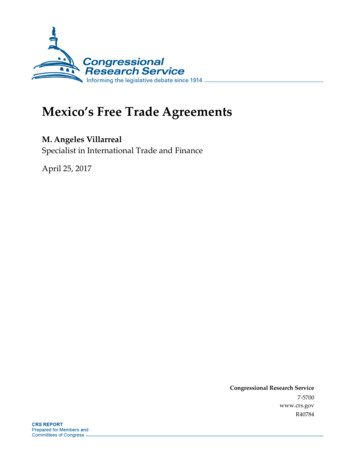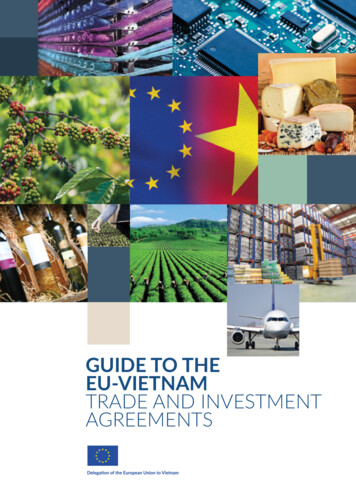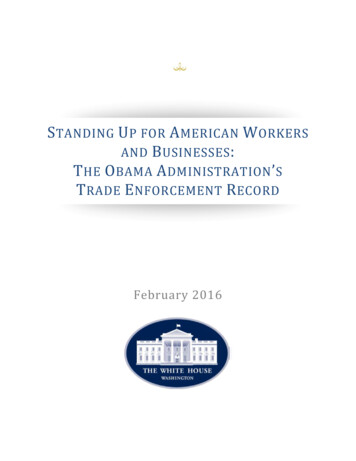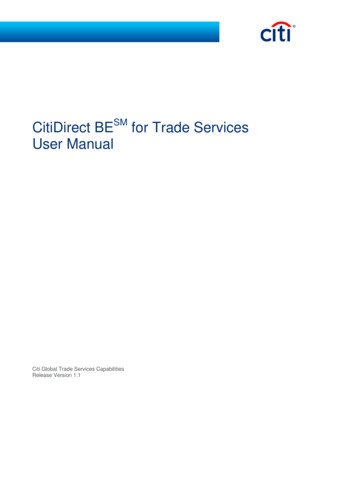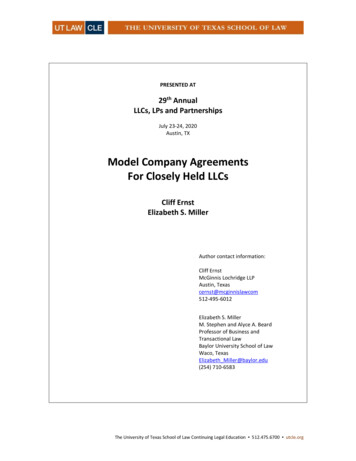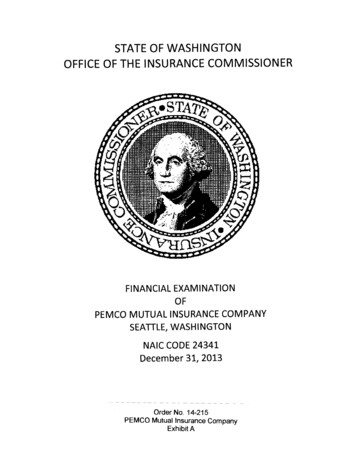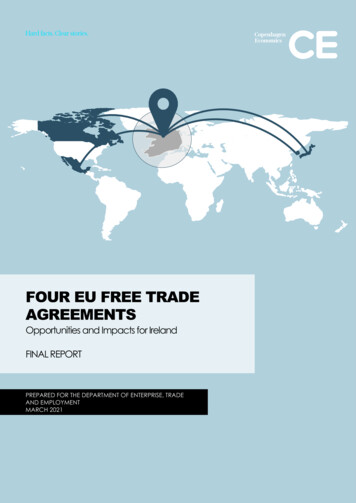
Transcription
FOUR EU FREE TRADEAGREEMENTSOpportunities and Impacts for IrelandFINAL REPORTPREPARED FOR THE DEPARTMENT OF ENTERPRISE, TRADEAND EMPLOYMENTMARCH 2021
AUTHORSSigurd Næss-SchmidtEva Rytter SunesenErik DahlbergMorten May HansenJoshua Brown
ACKNOWLEDGEMENTThis report is prepared for the Irish Government and has benefitted from valuable inputs from allthe stakeholders listed in Appendix A and from dialogue with the Department of Enterprise, Tradeand Employment and the Department of Agriculture, Food and the Marine.Copenhagen Economics would also like to acknowledge the contribution of Professor Joseph Francois and Professor Alan Mathews to this report.
Impacts of EU FTAs on IrelandTABLE OF CONTENTSAcknowledgement0Executive summary8Acronyms and definitions161Introduction and background171.1Purpose and scope of the study171.2Approach and method182The impact of the EU-South Korea FTA on Ireland’strade with South Korea242.1Ireland’s trade with South Korea242.2Overview of the EU–South Korea FTA262.3Realised impacts of the FTA on Ireland-SouthKorea trade282.4Long-run impacts on Ireland-South Korea trade 302.5FDI between Ireland and South Korea312.6Concluding remarks333Impacts of EU FTAS on Ireland’s trade withCanada, Japan and Mexico34
Impacts of EU FTAs on Ireland3.1Ireland’s trade with Canada, Japan and Mexico343.2EU FTAS with Canada, Japan and Mexico3.3Impacts of the FTAS on Irish trade with Canada,Japan and Mexico413.4Concluding remarks444Macroeconomic impacts of the FTAS464.1Impacts of the FTAS on Ireland’s global trade464.2Impacts of the FTAS on Irish GDP and nationalincome48Impacts of the FTAs on Irish wages, consumerprices and welfare494.4Concluding remarks515Sectoral impacts of the FTAS525.1Impacts of the FTAS on production across sectors525.2Main sectors to benefit from the FTAS545.3Sectors that should prepare to adjust595.4Concluding remarks606Policy conclusions and recommendations616.1Main policy Conclusions614.336
Impacts of EU FTAs on Ireland6.2Negotiating the best possible outcome for Ireland626.3Domestic policies to pursue the opportunities fromEU FTAS and mitigate challenges656.4Concluding remarksReferences6974
Impacts of EU FTAs on IrelandLIST OF TABLESTable 1 Tariffs on Irish exports to Canada, Japan andMexico – six sectors with the highest tariffs before theFTAs . 41Table 2 Impacts of the four FTAs in the othermanufacturing sector (percentage change relative to2030 baseline) . 55Table 3 Impacts of the four FTAs in the business and ICTsector (percentage change relative to 2030 baseline). 56Table 4 Impacts of the four FTAs in the chemicals (incl.pharmaceutical) sector (percentage change relativeto 2030 baseline). 57Table 5 Impacts of the four FTAs in the electricalmachinery sector (percentage change relative to 2030baseline) . 58Table 6 Impacts of the four FTAs in the wholesale andretail sector. 59Table 7 Market access for Irish exports of meat productsto Canada, Japan, Mexico, and South Korea . 68
Impacts of EU FTAs on IrelandLIST OF FIGURESFigure 1 Composition of Ireland’s exports of goods andservices, 2019 . 10Figure 2 Irish exports to South Korea, Canada, Japan,and Mexico, 2010-2019 . 13Figure 3 Irish exports of goods and services since 2010 14Figure 4 Irish imports from Japan, Canada, Mexico, andSouth Korea, 2010-2019 . 15Figure 5 Overview of the four EU FTAs analysed in thestudy . 18Figure 6 Sector composition used in the study . 21Figure 7 How to read the charts (illustrative figure) . 22Figure 8 Irish exports to South Korea, 2005-2019 . 25Figure 9 Irish imports from South Korea, 2005-2019 . 26Figure 10 Key elements and timeline of the EU-SouthKorea FTA . 27Figure 11 Impact of the EU-South Korea FTA on Irishexports to South Korea . 28Figure 12 Impact of the EU-South Korea FTA on Irishimports from South Korea . 29Figure 13 Impact of the EU–South Korea FTA on bilateraltrade by source of gain . 30Figure 14 Impact of the four FTAs on Irish trade withSouth Korea . 31Figure 15 Number of FDI projects between Ireland andSouth Korea, 2003-2016 . 32Figure 16 Average value of FDI projects betweenIreland and South Korea, 2003-2016 . 33Figure 17 Irish trade with Canada, Japan and Mexico,2019. 34
Impacts of EU FTAs on IrelandFigure 18 Irish exports of goods and services to Canada,Japan and Mexico, 2003-2019 . 35Figure 19 Irish imports of goods and services fromCanada, Japan and Mexico, 2003-2019. 36Figure 20 Overview of the elements in each FTA thathave been modelled . 40Figure 21 Expected impacts of the FTAs on Irish tradewith Canada, Japan and Mexico . 42Figure 22 Expected impacts of the four FTAs on Irishglobal exports, 2030 . 47Figure 23 Expected impacts of the four FTAs on Irishglobal imports, 2030 . 48Figure 24 Expected impacts of the four FTAs on IrishGDP, 2030 . 49Figure 25 Expected impact on real wages by skill groups. 50Figure 26 Expected impacts of the four FTAs on outputby sector . 53Figure 27 Overview of methodology used to assessexpected reductions in NTB costs . 72Figure 28 Cumulative impacts of EU FTAs areincorporated into the CGE model in two steps . 73
Impacts of EU FTAs on IrelandLIST OF BOXESBox 1 Non-technical description of the applied CGEmodel . 20Box 2 Chamber Trade Connections . 66
Impacts of EU FTAs on IrelandEXECUTIVE SUMMARYThe Department of Enterprise, Trade and Employment (DETE) has requested an analysis of the potential economic opportunities and other impacts on Ireland from recent EU Free Trade Agreements (FTAs). The analysis covers a total of four EU FTAs, of which one is already implemented(with South Korea) and three are concluded (with Canada, Japan and Mexico).In this study, we assess the economic impacts of these FTAs on the Irish economy. Our assessmentrelies in part on detailed model simulations for the Irish economy using an acknowledged Computable General Equilibrium (CGE) model. We use the CGE model to quantify the expected macroeconomic and sectoral impacts of the FTAs on the Irish economy in 2030. We do so by comparing twofuture states of the Irish economy: One without the FTAs and one with all FTAs in place and fullyimplemented.Aside from the model simulations, we have conducted interviews with a broad range of stakeholdersand undertaken a survey of the actual impacts of the EU-South Korea FTA experienced by Irishfirms. We combine insights from all sources to qualify our conclusions and to formulate policy recommendations.It is important to note upfront that the study measures the impacts of the FTAs in terms of the macroeconomic and sectoral opportunities and challenges they provide by increasing market access toFTA partners. In other words, the impacts are to be interpreted in terms of ‘all other things beingequal’ (i.e. on a ‘no policy change’ basis). They therefore do not account for strategies that the Enterprise Agencies or Business Representatives or firms may adapt to strategically target the marketsopened up under the FTAs, for example, by connecting Irish exporters with local buyers, supportingcompanies with market research, funding product diversification and innovation, or helping companies to navigate administrative and regulatory requirements in local markets.In addition, the impacts do not measure sub-sectoral or product shifts in a sector, which may notreveal, for example, moves to higher value-added products. It is also important to highlight thatthere are other FTA negotiations that the EU is engaged in or have recently completed, for examplewith Mercosur, Australia, New Zealand, Singapore, Vietnam, Chile, and Indonesia. As such, thestudy measures the impacts from a selection of EU FTAs and not the totality of opportunities provided by EU trade agreements.The FTAs will have a positive impact on the Irish economyOverall, the four EU FTAs will increase trade, firm productivity, GDP and national income in Ireland. Furthermore, real wages are expected to increase due to the FTAs, and the largest increasesare found for low income workers. When trade frictions are removed, imports become cheaper tothe benefit of consumers and Irish firms with global value chains. The increased market access benefits Irish exporters who can specialise in production, where they have a comparative advantage and8
Impacts of EU FTAs on Irelandare productive relative to competitors. Labour and capital will tend to relocate towards highly productive sectors, which will have a positive impact on Ireland’s productivity and therefore wages paidto Irish workers. As a small open economy with a limited home market, Irish producers will benefitmore than producers in large countries who can gain scale in their home markets.The impact of the FTAs on Irish overall trade depends on whether the increase in Irish trade with agiven partner country is new trade (trade creation) or whether it is diverted from other markets(trade diversion). The reduction in trade barriers vis-a-vis the FTA partners make the FTA partnersmore attractive relative to other trading partners, and Irish exports may be redirected from otherdestinations to the FTA partners. Redirected exports may be sold at a higher price, which will have apositive impact on the value of trade and GDP but may also leave production largely unchanged.Similarly, the impact depends on the extent to which Irish imports from the FTA partners replaceimports from other countries (at a lower price) or from local producers. Finally, the impact of theFTAs will depend on the actual utilisation of the agreements, for example, by companies availing oflower tariff rates.Generally, we see a strong, positive long run growth trajectory in Irish exports to the four tradingpartners without the FTAs. We therefore apply quantitative methods to isolate the impact of theFTAs. Overall, we find that the FTAs will impact positively on the Irish economy. We estimate thatIrish GDP will be 2.3 per cent higher in 2030 than would have been the case without the fourFTAs in place. The higher GDP is driven by an increase in global total Irish exports of 3.3per cent and an increase in global imports of 3.3 per cent. The FTA with South Korea had alreadyresulted in an increase of EUR 273 million in Irish exports to South Korea in 2015. Irish exportsto Japan are expected to increase dramatically as a result of the FTA.The EU Single Market and EU FTAs will cover 62 per cent of globalIrish exportsIn 2019, total Irish exports amounted to EUR 374 billion1 of which EUR 118 billion were destinedfor the EU and EUR 38 billion to the UK. This study covers Irish exports of goods and services toSouth Korea, Canada, Japan, and Mexico (the four FTA partners), which equalled a total of EUR 20billion, equivalent to 6 per cent of total Irish exports of goods and service in 2019.2 In addition tothe four FTA partners analysed in this study, the EU currently has in place 70 trade agreementswith third countries.3 Irish exports of goods and services to these 70 countries amounted to an additional EUR 30 billion in 2019 and accounted for 9 per cent of total Irish exports.4 The remainingEUR 133 billion exports are destined to other third countries.Including the four FTAs analysed in this study, EU FTAs and the EU Single Market cover around 62per cent of current global Irish exports.5 Irish exports to the four FTA partners have increased by12345The EUR 374 billion includes EUR 21 billion services exports that are not allocated to specific countries, based ondata from CSO.Excluding unallocated services exportsEuropean Commission, DG Trade’s website. This includes Customs Unions, Association Agreements, StabilisationAgreements, (Deep and Comprehensive) Free Trade Agreements and Economic Partnership Agreements. Theseare all agreements that as a minimum remove or reduce tariffs on bilateral trade and includes many smallerstates.Excluding unallocated services exportsBased on CSO data from 2019. Excluding unallocated services exports9
Impacts of EU FTAs on Ireland270 per cent over the period 2010-2019, which is more than total Irish exports which have increased 126 per cent in the same period. As exports tend to grow faster with third countries withwhom the EU has an FTA than in general, Irish exports to the FTA countries should be expected toincrease further once the four FTAs are fully implemented.Figure 1Composition of Ireland’s exports of goods and services, 2019EUR billion37421133169UK51EU26118EUNote:Source:30Third countries withwhich the EU has atrade agreementin place206%The four FTAThird countries withpartners covered which the EU do notin this studyhave a tradeagreement in placeNot allocatedservices exportsTotalEU26 is EU28 less the UK and Ireland. The four FTA partners in focus in this study include South Korea, Canada, Japan. The third countries that the EU has an agreement with is based on agreements as of 2019.Copenhagen Economics based on data from the CSOThe US accounts for 61 per cent (EUR 81.8 billion) of Ireland’s total exports to third countries withwhom the EU currently does not have a trade agreement in place. Goods exports from Ireland to theUS have grown by almost 150 per cent from 2013 to 2019, which is more than the general increasein Irish exports and also more than growth in Irish exports to the four FTA countries. An EU-USFTA would still be beneficial to the Irish economy and it is estimated could add up to 1.1 per cent toIreland’s GDP.6Main sectors of opportunities for IrelandGains from the EU FTAs are expected to have positive impacts on 5 sectors in Ireland: Business andICT services, Chemicals (incl. pharmaceuticals), Electrical machinery, Wholesale and retail, andOther manufacturing. These sectors account for 89 per cent of the total net increase in output fromthe FTAs. The sectors are also expected to have large increases in exports, thus showing that theFTAs are opening new market opportunities for Irish firms.The FTAs reduce trade costs and the positive impact on these sectors not only suggests that Irelandhas a comparative advantage in these sectors, but also that these Irish comparative advantageswould be inhibited should the FTAs not be implemented. The FTAs enable a more efficient resourceallocation that contributes to a higher level of output and income in Ireland, showing that Irishfirms are globally competitive and that the opening up of new business opportunities is a boon6See Copenhagen Economics (2015), TTIP impact in Ireland.10
Impacts of EU FTAs on Irelandto the Irish economy. This is not just true for exporting firms, but also for Irish firms who supplyinputs to exporting firms, and for Irish firms who rely on foreign inputs for their production.Furthermore, the reduction of tariffs, simplified customs procedures and more harmonisation oftechnical requirements, enhanced market access information will make it easier for small andmedium sized enterprises (SMEs) to engage in international trade, either directly as traders oras suppliers to other firms. While the benefits of the FTAs accrue to both larger and smaller firms,the latter may see larger relative total cost reductions from the removal of trade barriers, which mayenable them to move from supplying the domestic or neighbouring markets to also reach farawaymarkets to a greater extent than without FTAs.Main sectors where Ireland should prepare for adjustmentsThe FTAs open up the EU (and Irish) markets to competition from FTA partners, which means thatnot every sector in Ireland will be impacted positively, thereby presenting a competitiveness challenge. Irish producers of dairy, financial services, insurance, motor vehicles and parts, other machinery, and other transport equipment may experience increased competition in Ireland and theEU. Taking this competitive challenge to avoid firm or job losses within these sectors could, for example, involve looking for new export markets, cost competitiveness measures or product innovation. Note that impacts are presented as net effects on sectors and do not take account of individualfirm level responses.Policy responses to meet challenges and maximise opportunitiesfrom the FTAsBased on the analysis and engagement with stakeholders, 5 policy areas were identified as important in order to meet challenges and maximise opportunities from the FTAs. The 5 areas were:SME chapters, increased international cooperation by standardising bodies, protection and enforcement of intellectual property rights, protection of geographical indications, and distribution of EUtariff rate quotas (TRQs) for beef and sheep meat.The policy responses focus on removing or minimising barriers to trade while still protecting intellectual property rights and geographical indicators.The policy focus in Ireland should be to pursue the export opportunities arising from the FTAs. Thiscan be achieved through policies to raise the awareness and understanding of FTAs, policies to helpIrish firms access export markets in the FTA countries and policies to upgrade skills and promoteR&D.2021 updateThe main research was undertaken in 2018—2019. In March 2021, we updated the Irish trade figures in the report from 2016 up to and including 2019 (2020 for goods trade). This gave us a chanceto look back at the development since the original report. During this period, the Canada FTA(CETA) was provisionally applied in 2017, and the Japan FTA entered into force in 2019. Also, therehas been continuous implementation of the EU and South Korea FTA after being provisionally applied in 2011 and formally ratified in 2015. The agreement with Mexico was agreed in principle in11
Impacts of EU FTAs on Ireland2018 and is in the process of being implemented. None of the FTAs have been fully implementedyet, but the implementation of the FTAs may have affected Irish trade in the years following theirrespective applications.Irish exports of goods and services to the FTA partners have increased since the start of their respective implementations, cf. Figure 2. Exports to South Korea already started to increase after theprovisional application of the South Korea FTA in 2011. Since the initial implementation of theSouth Korea FTA, Irish services exports have almost tripled from EUR 655 million in 2014 to EUR1.8 billion in 2019 (22.8 percent increase p.a.). Goods exports have also increased but peaked in2016.A similar trend is seen for Canada after the provisional application of CETA in 2017. Irish exportshave increased for both goods and services: Goods increased from EUR 953 million in 2016 to morethan EUR 1.7 billion in 2020 (15.8 per cent increase p.a.), mainly due to increased exports of chemicals.7 Services exports grew from EUR 1.6 billion in 2016 to more than EUR 2.3 billion in 2019 (13.6per cent increase p.a.).For Irish exports of goods and services to Japan and Mexico, there appears to be an increase intrade after respective implementations, especially for services exports to Mexico that grew fromEUR 688 million in 2017 to almost EUR 1.6 billion in 2019 (50.6 per cent increase p.a.).These export developments indicate that the impacts of the FTAs are starting to show, but Irishgoods and services exports to the FTA partners were also increasing before the FTAs. However, aproportion of increased exports are due to the implementation of the FTAs, see for example the results for South Korea in Figure 11 which estimates that Irish exports to South Korea was 31 per centhigher in 2015 than would have been the case without the FTA in place.7Based on data from Eurostat.12
Impacts of EU FTAs on IrelandFigure 2 Irish exports to South Korea, Canada, Japan, and Mexico, 2010-2019EUR billion, 2019 pricesGoodsServicesFTA in placeSouth 9249472016FTA in A in 201820192020Update of FTAagreed in udes goods and services. Services exports are not available for 2020. There is a small difference in the2016 numbers from the previous report since the numbers are measured in 2019-prices. The Canada FTA(CETA) was provisionally applied in 2017. The EU-Mexico FTA, was agreed in principle in April 2018 and theEU-Japan FTA was agreed in 2017 and entered into force on 1 February 2019.Copenhagen Economics based on data from CSO.13
Impacts of EU FTAs on IrelandIn recent years, Irish exports have in general grown, cf. Figure 3. In the past 5 years during whichthe FTAs started to be implemented at various stages, Irish exports to Canada, Japan and Mexicohave grown faster than exports to the rest of the world at around 17.5 per cent per year on averagecompared to 14.0 percent to the rest of the world. Exports to South Korea grew 19 per cent per yearsince 2015 and 22.8 per cent per year since 2017. The FTA with South Korea has already contributed to export growth (see Figure 11) and further opportunities are expected under the FTAs goingforward. Although still at an early stage of application, there are indications that a similar development is arising with exports to Canada, with Irish exports increasing by 15 per cent per year since2016. There are also early indications of export growth in in the case for the Japan FTA and the updated Mexico FTA, for example goods and services exports to Mexico have increased 20 per cent peryear since 2017. Overall, export are expected to increase more going forward when the FTAs arefully implemented and the full benefits for exporters and consumers are utilised in the long-run (seeChapters 2 and 3 for further details).Figure 3Irish exports of goods and services since 2010Index, 2010 100400Four FTA countries2014-2019: 17.5%30020010002010Note:Source:Rest of world2014-2019: 14.0%Four FTA countries2010-2014: 12.0%Rest of world2010-2014: 1.4%201120122013201420152016201720182019The index is based on exports in 2019 prices. The percantages show the compound annual growth rate(CAGR). The cutoff is set before the implementation of the first FTA in 2015.Copenhagen Economics based on data from the CSO.Since 2014, imports from the FTA partners have also increased, although at a lower rate, cf. Figure4. Imports have increased from EUR 0.6 billion in 2014 to EUR 1.1 billion in 2019 for both SouthKorea and Canada, whereas imports from Japan and Mexico have remained relatively stable. Similarly to the exports, there are also indications of increasing Irish imports, mainly from South Koreaand Canada after the implementations of the respective FTAs.14
Impacts of EU FTAs on IrelandFigure 4Irish imports from Japan, Canada, Mexico, and South Korea, 2010-2019EUR billion, 2019 30.95.45.14.8CanadaMexicoSouth KoreaIncludes goods and services. There is a small difference in the 2016 numbers from the previous report sincethe numbers are measured in 2019-prices.Copenhagen Economics based on data from CSO.15
Impacts of EU FTAs on IrelandACRONYMS AND NM&AsNTBR&DSMETariffTRQUKWTOCompound Annual Growth RateComputable General Equilibrium (see Appendix B)Central Statistics Office in IrelandDepartment of Enterprise, Trade and EmploymentEuropean Economic Area: The EEA comprises the 28 EU member states, as well asthree of the four member states of the EFTA (Iceland, Liechtenstein and Norway).Membership provides for the free movement of persons, goods, services and capitalwithin the European Single MarketEuropean UnionForeign Direct Investment (investments with a foreign ownership above 10 percent)Free Trade Agreement: An FTA is an agreement between two or more countries thatestablishes the free exchange of goods and services among parties. Each party to anFTA retains its own independent trade regime with respect to non-members (unlikethe case of a customs union). FTAs are subject to the disciplines and oversight ofthe WTOGross Domestic Product: The market value of all goods and services produced in acountry in a yearGeographical indication (a name or sign used on products which corresponds to aspecific geographical location or origin)Global Trade Analysis Project database: Global data base describing bilateral tradepatterns, production, consumption and intermediate use of commodities and servicesInformation and Communication TechnologyMost Favoured Nation: MFN is the cornerstone of non-discrimination among WTOmembers. Any favourable treatment provided by a WTO member to any othercountry must immediately and unconditionally be provided to all other WTO membersMerger & Acquisition (foreign takeover of a local firm)Non-Tariff Barrier (import quotas, subsidies, customs delays, technical barriers orother obstacles to trade besides tariffs)Research & DevelopmentSmall and Medium-sized Enterprise (10-250 employees)A duty levied on goods entering a new customs area – sometimes referred to as acustoms dutyTariff Rate Quota: A quota within which imports enter a market with a tariff advantage. A TRQ is a volume of imports whose tariff is lower than the tariff chargedfor imports above the quotaUnited KingdomWorld Trade Organisation: The WTO is the international organisation dealing withthe rules of trade between nations. Its goal is to ensure that trade flows as smoothly,predictably and freely as possible16
Impacts of EU FTAs on IrelandCHAPTER 1INTRODUCTION AND BACKGROUNDIn this chapter, we provide the background to the study, its purpose and the scope of the impact assessment. We conclude by introducing the approach and method we use in the study.1.1PURPOSE AND SCOPE OF THE STUDYEU trade agreements broaden market opportunities for EU exporters and give EU firms and consumers access to a wider range of products at lower prices. OECD (2018) finds that lower trade barriers are particularly beneficial for smaller economies, because “firms in these economies can betterspecialise in international production networks as they have access to larger and more differentiated markets and also benefit from enhanced market access on the products they already produce.”The purpose of this study is to quantify the cumulative impact of EU FTAs on the Irish economy.The FTAs include the 1) EU-South Korea agreement, which is already in force and close to fully implemented, and 2) the EU-Canada, EU-Japan, and EU-Mexico agreements, which are concludedand are in the process of being implemented,8 cf. Figure 5.The EU-Canada FTA (CETA) has been provisionally applied since September 2017. The majority ofthe provisions in the agreement are therefore in force now, with the exception of a few provisionsmainly related to investment.9 The EU-Japan FTA (EU-Japan Economic Partnership Agreement)entered into force in Februrary 2019 and tarrif reductions on sensitive products are subject to aphasing period of up to seven years.10 11 The EU and Mexico reached an agreement in principle onthe trade part of a modernised EU-Mexico Global Agreement in April 2018. The new EU-MexicoFTA is in the process of being implemented and will replace a previous agreement between the EUand Mexico from 2000. While the three trade agreements have in principle been concluded, theirimpacts on Irish trade and GDP largely remain to be seen.891011The EU-Canada FTA provisionally entered into force on the 21 September 2017. Most of the agreement now applies, with the exception of some provisions mainly related to investment (European Parliament website, 2018).The EU-Japan agre
the four FTA partners analysed in this study, the EU currently has in place 70 trade agreements with third countries. 3 Irish exports of goods and services to these 70 countries amounted to an addi- tional EUR 30 billion in
